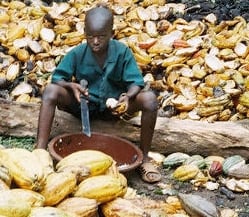The Court of Chancery for the State of Delaware allowed the case to proceed despite an earlier Master’s recommendation to dismiss for lack of evidence.
“I reach a different conclusion than the recommendation and I am denying the motion to dismiss,” said Judge Travis Laster on Tuesday.
The claimant, Louisiana Municipal Police Employees' Retirement System (LAMPERS), a Hershey shareholder, seeks a court order permitting it to inspect the chocolate company’s books.
Judge Laster ruled that a trial will be held where he will assess Hershey’s documents before deciding whether to allow LAMPERS to inspect. The documents are expected to contain details of Hershey’s suppliers and sourcing practices, which it had previously refused to disclose.
Hershey: 'Unmerited effort' to inspect our records
Jeff Beckman, director of corporate communications at Hershey said: "The Court made it clear in its ruling that it was not suggesting there was any actual wrongdoing or even that the plaintiff would ultimately be permitted to inspect Hershey’s records.
"We respect the Court’s decision and will vigorously defend against this overly-broad and unmerited effort to examine our confidential records."
We contacted the lawyers for LAMPERS and are awaiting comment.
West Africa cocoa sourcing
Laws in the Ivory Coast and Ghana, which account for 70% of the global cocoa supply, forbid forcing children to engage in dangerous activities such as carrying heavy loads and using machetes.
“Those laws are routinely violated; hence, the use of child and forced labor is, indeed, pervasive,” said Laster.
An earlier case (Doe v Nestlé) found that it was possible for a US corporation to be liable for aiding and abetting offences in international law, such as principles against child labor and human trafficking.
Harkin-Engel Protocol
Hershey and other chocolate companies signed the 2001 Harkin-Engel Protocol, committing to eliminate the worst forms of child labor by July 2005.
By 2010, it was acknowledged that the Harkin-Engel Protocol hadn’t gone to plan and a new framework was drawn up to eliminate the worst forms of child labor by 2020 instead.
Child labor still rife

Ten years after the protocol, a 2011 report from the Payson Center for International Development at Tulane University found that child labor in the cocoa industry was still rife.
“Basically the Payson Report documents all the worst ills that one could imagine about this problem. Nearly two million children work illegally on cocoa farms. There's evidence of widespread violations of human trafficking laws,” said Laster.
Hershey accounts for 43% of the world’s largest chocolate market: the US.
In October 2013 the firm announced that by 2020 its entire cocoa supply would come from certified farms, which are audited to stamp out illegal child labor. In January this year it reported that 18% currently comes from certified organizations such as UTZ certified, Fair Trade USA and Rainforest Alliance.
“…Right now Hershey's has to acknowledge that some of its cocoa is produced through child labor and as a result of individuals who were the victims of human trafficking,” said Laster.
“If I call up, you know, my daughter's school and I say, ‘Can you confirm for me that there's no one on the payroll with a criminal record?’ and they say to me, ‘We're not going to do that now, but we hope to be able to do so in 2020,’ I'm going to draw the inference that they can't do it right now and there's probably someone at the school with a criminal record.”
Inference that Hershey knew
The judge said there was a reasonable inference that Hershey’s products contained cocoa derived from child labor and human trafficking and also an inference the Hershey knew about it. He said the Master’s report had assessed illegal conduct rather than “possible mismanagement”, which required a lower standard of proof.
The trail was therefore allowed to proceed.
